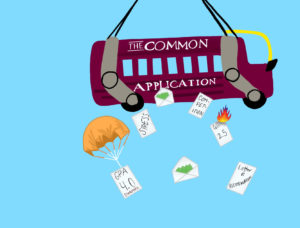How a fierce college admissions process is destroying us as students (and what those in charge should do about it)

By Tate Evans
To any up-and-coming high schooler cursed with the dreams of attending a select college when they graduate high school, the statistics are truly gruesome. Roughly speaking, selective institutions—schools which only accept half of all their total applicants—regularly accept 1/5 of the nations incoming freshmen, but are the end destination for 1/3 of our collective applications. Top schools such as Harvard and Stanford regularly report admission rates hovering around 5%, or numerically, just a measly 2,040 incoming students out of a hefty 47,450 applicant pool (2018) in the case of the latter.
In what is essentially an academic battle royale with an ever-increasing pool of competitors, it is easy to see the inherent flaws in the system. There are hundreds of thousands of students, from the quaint DHS to top-tier prep schools 7,233 miles over the pacific in China, who all yearn for the exact same prize. Stress, anxiety, sleep deprivation, and depression are all logical conclusions of this system, where emotionally inexperienced teens are thrust wholeheartedly into an international arms race of extracurriculars, GPAs, and SAT scores. To people who have barely scratched the surface of what life really means, this slog for prestige represents their only means of true validation, the ultimate path toward true social acceptance in our society.
Arms races usually revolve around overreactions, and in college application terms, that is represented by the ever rising amount of applications the average student sends out each year. According to the National Association for College Admission Counseling, 36 percent of first-time freshmen applied to seven or more colleges in the fall of 2015, roughly 19 points higher than in 2005. Within that same timeframe, most selective colleges saw their acceptance rates decrease. It seems as competition increases, students feel incentivized to apply to as many colleges as possible, as to widen their chances of getting into an agreeable school. Ironically, this over applying is what has caused the plummeting acceptance rates, with school inboxes becoming flooded with letters that only years before would never have been sent.
There is a reason why in 2005 a school such as UChicago’s acceptance rate was 40% and has in 2018 dropped to a paltry 8%, and it’s not because it suddenly started educating better or invested millions in new facilities, but because it swapped it’s “uncommon” application for the Common App. It’s simple arithmetic: a corporate style advertisement offensive combined with the ease of clicking UChicago onto a Common Application listing meant thousands of students who would have never considered the school applied. While it’s great for boosting UChicago’s prestige and national rankings, it’s the students who ultimately lose.
Before the Common App, the majority of those applying to UChicago were students who craved a specific academic challenge, who worked on their singular admission because they wanted the specific environment UChicago provided. Now, however, with the Common App taking the risk factor out of college applications by streamlining the process, students now have almost no incentive to only apply to the colleges that best fit them as its no longer a real challenge to apply. While a student could just apply to the schools best for his engineering program, its much more likely they end up also applying to several more colleges based on non-academic factors (like prestige) because of how easy the Common App makes the process. The detriment of this is that students who could do best at a certain school simply don’t get accepted, as the swarm of applications from those who would normally never give the school a second thought but apply anyways on a whim dilute the pool.
The Common App is a godsend in that it helps alleviate stress from our lives by decreasing our application workload, but that stress is just being handed back to us on a rejection-stamped platter by not realistically capping the amount of colleges we can apply to via their service. I think it’s reasonable to say if we had a real limit on the amount of colleges we could apply to, we would consider those colleges much more carefully, and actually research which ones are the best fit for ourselves instead of cramming a letter into the inbox of every school on the eastern seaboard. Currently, College board sets the cap at “only” 20 colleges. While the drive of someone with the iron hands to write that many supplementals is admirable, it’s doubtful more than a handful of students are even aware of its existence or effected by it whatsoever.
A more effective college cap would be something below double digits, such as five or six, that both gives applicants reasonable room for college diversity while at the same time guiding them into thinking about the weight of their applications. If students wish to apply to more colleges, they are more than welcome to submit a custom application to said institution(s), but that’s their prerogative. A two reach, two match, and two safety application strategy under a six college limit through the Common App would be the perfect mix for most students, minimizing their stresses by limiting workload and incentivising them to apply only to colleges that are a true match for their chosen path. While such a solution is somewhat unlikely to ever be taken up, it would be beneficial to all those applying to college in their senior year at DHS to take the sentiment of it to heart. Prestige and name brand alone do not define your education nor your future, for the only thing that matters after college isn’t the swag of your alma mater, but the experiences and education you gained along the way.
